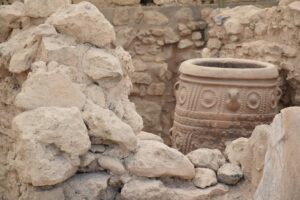 The Ancient Greek Bronze Age, also known as the Aegean Bronze Age, refers to a period in Greek history characterized by the extensive use of bronze for tools, weapons, and artwork. From around 3000 B.C. to 1100 B.C., this era witnessed the rise and fall of several civilizations in the Aegean region, leaving behind a rich cultural heritage and profound influence on subsequent Greek civilization. Here we will explore the significant developments and civilizations of the Ancient Greek Bronze Age.
The Ancient Greek Bronze Age, also known as the Aegean Bronze Age, refers to a period in Greek history characterized by the extensive use of bronze for tools, weapons, and artwork. From around 3000 B.C. to 1100 B.C., this era witnessed the rise and fall of several civilizations in the Aegean region, leaving behind a rich cultural heritage and profound influence on subsequent Greek civilization. Here we will explore the significant developments and civilizations of the Ancient Greek Bronze Age.
About the Greek Bronze Age
The Aegean Bronze Age began with the emergence of advanced cultures in the Aegean Sea region. The Cycladic, Minoan, and Mycenaean civilizations were the most prominent during this period. These societies thrived on trade, agriculture, and maritime activities, which laid the foundation for their cultural and economic growth.
Cycladic Civilization
The Cycladic Civilization, which was a main part of the Bronze Age flourishing from approximately 3000 B.C. to 2000 B.C., inhabited the Cyclades islands in the Aegean Sea. Known for their distinctive marble figurines and art, the Cycladic people established a maritime network and traded with neighboring regions. They developed an early form of writing known as Linear A, although it still needs to be completed.
Minoan Civilization
The Minoan civilization, centered on the island of Crete, emerged around 2600 BCE and lasted until 1100 BCE. Vibrant cities, advanced architecture, and an extensive trade network throughout the Mediterranean characterized it. The Minoans are renowned for their remarkable palaces, such as Knossos, adorned with elaborate frescoes and featuring complex drainage systems. Their script, Linear A, remains undeciphered, but Linear B, an adaptation used by the Mycenaeans, was eventually deciphered.
Mycenaean Civilization
The Mycenaean civilization flourished from approximately 1600 BCE to 1100 BCE and dominated the Greek mainland and several islands, including Crete. Known for their formidable fortresses, such as Mycenae and Tiryns, the Mycenaeans developed a highly organized and militaristic society. They established an extensive trade network and were skilled metalworkers, producing intricate bronze weapons, armor, and artworks. The Mycenaeans are credited with the earliest form of written Greek, Linear B, used for administrative purposes.
Collapse of the Aegean Bronze Age
The Aegean Bronze Age ended abruptly around 1100 B.C. due to a series of calamities. The causes of the collapse remain debated among scholars, but theories suggest a combination of factors such as natural disasters, invasion by outside forces, and internal unrest. This catastrophic event led to the decline and eventual disappearance of the Mycenaean civilization, leaving the region fragmented and susceptible to the so-called Dark Age.
The Ancient Greek (Aegean) Bronze Age represents a significant period in Greek history, characterized by remarkable cultural achievements and advancements in trade, architecture, and craftsmanship. The Cycladic, Minoan, and Mycenaean civilizations played pivotal roles in shaping the Aegean region and laying the groundwork for future Greek civilization.
Although the collapse of the Aegean Bronze Age was a profound setback, its influence and legacy continued to resonate in the subsequent eras of Greek history. The Ancient Greek Bronze Age serves as a testament to the ingenuity and creativity of the people who inhabited this region thousands of years ago, leaving an enduring impact on the development of Western civilization.
Sources: